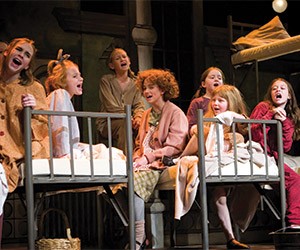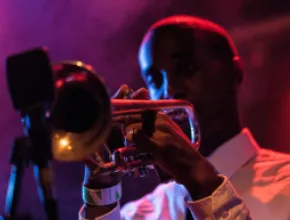For a state that only joined the Union in 1867, Nebraska offers plenty of well-established historic sites. These venues commemorate everything from the natural wonders that Europeans first encountered on wagon trains, to grand railroad stations now refurbished to the peak of their glory, to humble log cabins that typify the lives of the state’s earliest farmers. Any one is worth a look for an off-site gathering, and some even have dedicated meeting space.
Durham Museum, Omaha
The building that houses the Durham Museum was built by the Union Pacific railroad in 1931 to accommodate fast-rising rail passenger traffic through Omaha. Up to 10,000 passengers in 64 trains per day would transit through the Art Deco Union Station, but passenger rail travel declined and the station closed in 1971. In 1995, a $22 million renovation project began, and local donors and others restored the 65-foot-high Great Hall and what is now the Durham Museum, adding other spaces as they went.
Permanent exhibits here spotlight topics such as transportation, coins and documents, architecture and immigration. The station’s original soda fountain is back in operation and serves old-fashioned “phosphates” (i.e. ice-cream floats) and nostalgic candy.
“Visitors can explore trains trackside and hop onboard historic train cars, including the one used by President Harry S. Truman during press events,” says Deborah Ward, director of marketing and communications at the Omaha CVB.
Grand Manse, Lincoln
The Beaux Arts Grand Manse is another beautiful remnant of Nebraska’s early 20th century boom. It began life in 1906 as the city’s U.S. Post Office and federal courthouse, with additions in 1916 and 1941.
The Grand Manse has since been extensively refurbished by private owners determined to keep the best features of the building—oak Corinthian pillars, a marble grand staircase—while raising everything else to a similarly high level. The third-floor courtroom is now the Grand Hall, with the former judge’s bench turned into a bar and the jury box into a buffet area, and visitors can dine where courtroom spectators once sat. The former mail-sorting room is now the ornately appointed Jasmine Room, with an antique bar and French doors opening onto a patio, while two of the original vaults recently became the Vault, with big windows that allow natural light to stream onto beautiful hardwood floors and old-school post-office teller windows.PageBreak
Sarpy County Historical Museum, Bellevue
On the site of the old Omaha and Southern Railroad Depot, the Sarpy County Museum is known as “Nebraska’s Birthplace” for the age and quality of its buildings and exhibits, the most prominent of which is the Bellevue Log Cabin, Nebraska’s oldest structure. Built by hand from cottonwood during the 1830s, it was occupied by just three families between 1856 and 1950.
The museum site also features the state’s oldest church building—the 1856 First Presbyterian Church, with oak pews and stained-glass windows—and oldest public commercial building, the Fontenelle Bank, with an original vault that remains intact.
Exhibits in these and other buildings chronicle Nebraska’s growth and, more locally, Bellevue’s growth since pioneer days.
Evans House, Columbus
Local doctor C.D. Evans built this 28-room mansion between 1908 and 1911 at a cost of $85,000—which doesn’t seem like much until you realize that’s equivalent to about $3 million today. And it shows. Current owners Carol and Pat Mueller have worked to restore the building, which incorporates Renaissance, Greek and Spanish Colonial elements, to an original floor plan that had been hidden by subsequent renovations.
In the process they’ve made surprising discoveries, such as a stairway connecting an unoccupied apartment with a lower-level room known as the “Bunny Club” (i.e. a combination “gentlemen’s club” and gambling parlor).
While some things have changed since the Evanses lived here—several of the mansion’s rooms now serve as business offices—the Muellers have retained the entryway lions that served as the Evans family crests. Visitors can appreciate them on their way to one of the building’s two small meeting spaces.
Elkhorn Valley Museum, Norfolk
While the Elkhorn Valley Museum’s main mission is to describe the history of this part of northeast Nebraska, with exhibits devoted to subjects as varied as food, medicine and innovations in farm machinery, the museum’s gaze justifiably wanders toward its most famous son: Johnny Carson, who considered Norfolk to be his hometown.
The entertainer has his own gallery at the museum, focusing on his early years in Norfolk and celebrating his Nebraska radio career as well as his three-decade run on The Tonight Show. (Carson himself selected the items for display here before his death in 2005.)PageBreak
Stuhr Museum, Grand Island
The Stuhr Museum has multiple sites. First-time visitors will focus on the strikingly modern museum building, whose appearance and decor echo Washington’s Kennedy Center for the Performing Arts because they share the same architect, Edward Durell Stone.
From there visitors can journey backward in time through various exhibits on a sprawling campus. The Antique Auto and Farm Machinery Exhibit has 200 pieces, including early steam engines and horse- and tractor-drawn implements; a trail marker and pioneer cabins commemorate the Oregon Trail; the Fonda House shows where actor Henry Fonda grew up; a Pawnee earth lodge demonstrates how the area’s Plains Indians lived communally up until the 19th century; and a striking bronze statue in the museum, The Arrowmaker, evokes one Plains Indian family’s life visually.
Golden Spike Tower, North Platte
Nothing shows how central the railroads have been—and continue to be—in Nebraska’s history like the Golden Spike Tower. This observation platform overlooks the Union Pacific’s Bailey Yard, a 2,850-acre switching operation that is the world’s largest railyard. It resembles a giant air-traffic control tower, from which visitors can watch entire trains be taken apart and rebuilt on the fly, says Ginger Ady, who works in group and convention sales at the Lincoln County CVB in North Platte.
“Say we have a train coming from California and each one of its cars has a different destination—the first to Chicago, the next to Florida, all sorts of destinations,” Ady says. “They have a scanner on the hilltop that knows where that car is supposed to go. It tells the person pulling the pins on the car how many cars they’re going to cut. Say they’ll cut three of them. Those three will roll down the hill and veer into one of the hundreds of tracks at the bottom to form a new train going to that destination.”
Scotts Bluff National Monument, Gering
Many European pioneers heading west on the Oregon Trail kept journals of their travels, and the most-noted landmark on their journey was Scotts Bluff, a magnificent set of rock formations that loom 800 feet over the North Platte River. Named for fur trapper Hiram Scott, today’s Scotts Bluff National Monument draws 120,000 visitors per year for its history, fossils and the inherent drama of the bluff’s geography.
“Today you can stand on top of Scotts Bluff and look east and see Chimney Rock [National Historic Site], and then to the west, you can see Laramie, Wyoming,” says Karla Niedan-Streeks, executive director of the Gering CVB. “On a clear day, it’s extremely visible.”
Paul D. Kretkowski writes frequently about travel, food and sports. He is also the founder of Beacon, a blog about foreign policy.






